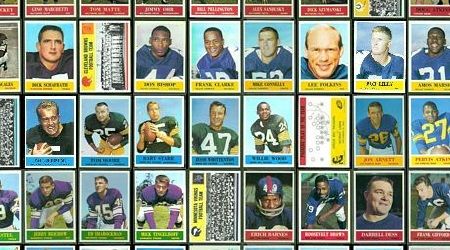December 30th, 2012 |
Published in
New in the Gallery
As I wrote last week, I recently won a group of crudely hand-cut 1961 Fleer Baltimore Colts cards on eBay. I thought that by piecing them together, I might be able to figure out the configuration of uncut sheets of first series 1961 Fleer cards. Well, I got the cards, and most of them indeed fit together. Though I haven’t quite figured out what a full sheet looked like, the cards gave me a pretty good clue. You can see the details toward the bottom of my 1961 Fleer virtual uncut sheet page.
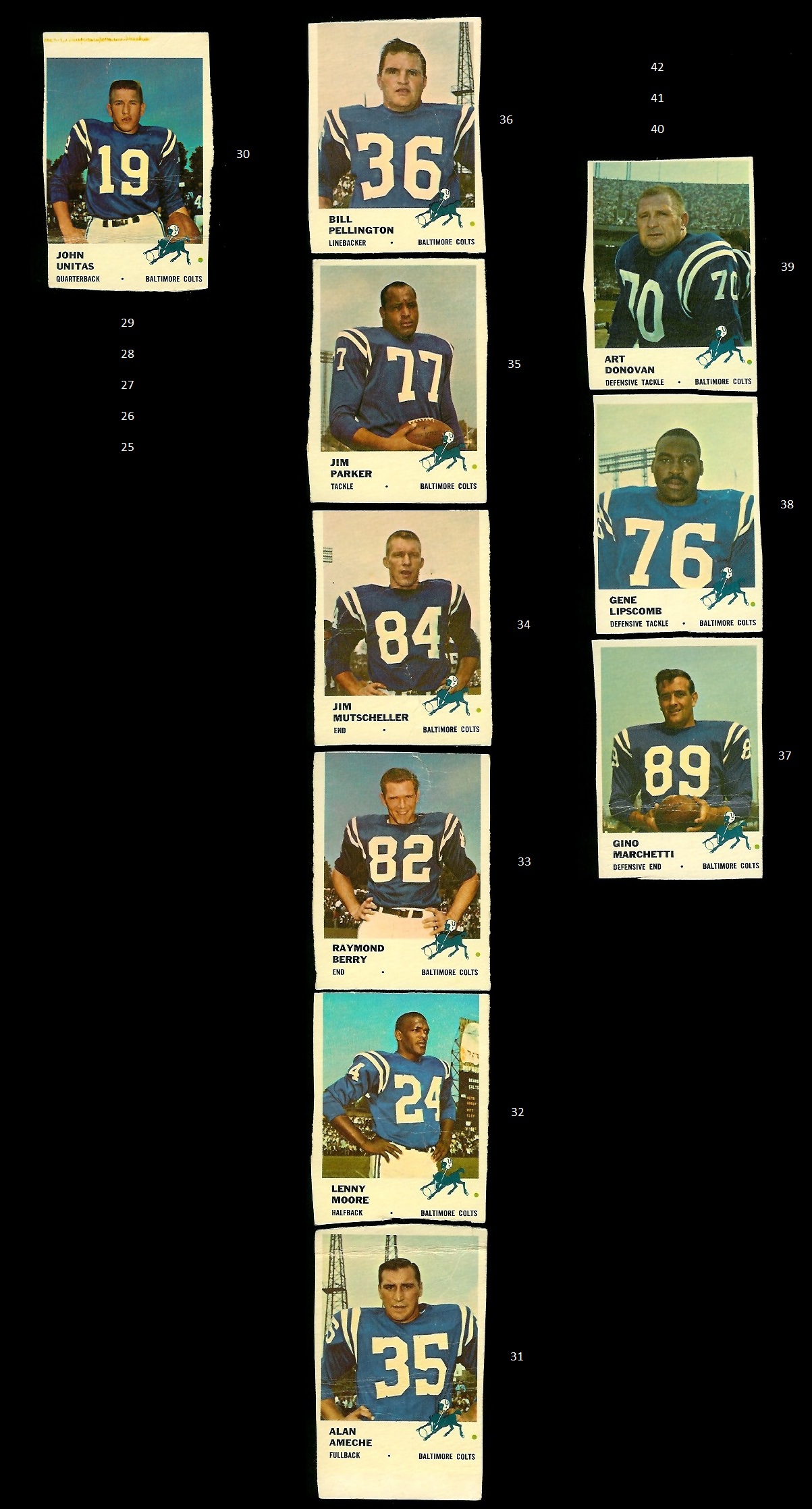
December 20th, 2012 |
Published in
Interesting eBay Auctions
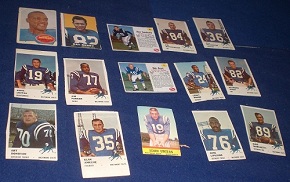 In last week’s “Interesting eBay Auctions” article, one of the auctions I featured was a group of sheet-cut and otherwise trimmed 1960s Baltimore Colts cards. Well, I ended up winning the auction myself. Really, for resale, you’re wondering? No, I wanted them because they might help me figure out what a first series 1961 Fleer uncut sheet looked like. I have seen pictures of second series 1961 Fleer sheets (see my 1961 Fleer virtual uncut sheet page), but I haven’t yet seen a first series sheet. I’m hoping that the edges of the hand-cut cards from the eBay lot will fit together such that I can deduce the numbering pattern of the first series sheet.
In last week’s “Interesting eBay Auctions” article, one of the auctions I featured was a group of sheet-cut and otherwise trimmed 1960s Baltimore Colts cards. Well, I ended up winning the auction myself. Really, for resale, you’re wondering? No, I wanted them because they might help me figure out what a first series 1961 Fleer uncut sheet looked like. I have seen pictures of second series 1961 Fleer sheets (see my 1961 Fleer virtual uncut sheet page), but I haven’t yet seen a first series sheet. I’m hoping that the edges of the hand-cut cards from the eBay lot will fit together such that I can deduce the numbering pattern of the first series sheet.
As a bonus, the lot includes a 1961 Topps Raymond Berry card that is showing part of the card next to it. That should provide another piece to the first series 1961 Topps virtual uncut sheet that I am assembling. Stay tuned; I’ll post what I learn here.
As always, if you encounter uncut panels or miscut cards that you think could help me piece together an old sheet, please send me an email. See the bottom of a previous blog article, “U is for Uncut Sheets,” for a full list of the sheets I have worked on, both complete and incomplete.
November 28th, 2012 |
Published in
New in the Gallery
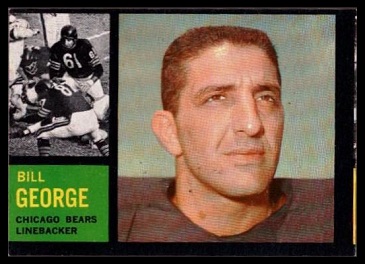 I have seen one half of a sheet of 1962 Topps football cards, but not the second half. By looking at badly miscut cards, however, I have been able to start piecing the second half-sheet together. You can tell from this Bill George card, for instance, that Dave Baker’s card was next to it on the uncut sheet. Neither of the cards appear on the one half-sheet I have seen, so they must have been on the second half-sheet.
I have seen one half of a sheet of 1962 Topps football cards, but not the second half. By looking at badly miscut cards, however, I have been able to start piecing the second half-sheet together. You can tell from this Bill George card, for instance, that Dave Baker’s card was next to it on the uncut sheet. Neither of the cards appear on the one half-sheet I have seen, so they must have been on the second half-sheet.
To see the layout of the first half-sheet and my progress on the second half-sheet, see my 1962 Topps virtual uncut sheet page. For a full list of the virtual uncut sheets I have assembled, see a previous blog article, U is for Uncut Sheets.
October 13th, 2012 |
Published in
New in the Gallery
Yesterday I found two more clues as to how uncut sheets of 1965, 1966, and 1967 Philadelphia football cards were configured. From looking at miscut cards, I have determined that uncut sheets from those three sets all had the same numbering scheme, so finding a piece of one helps me with all three. See the last section of my sheets in progress page for details.
Here are the new clues: a Saints team card with a sliver of Sonny Jurgensen’s card showing on the left, and a Bears insignia card with a sliver of a St. Louis Cardinals insignia card showing on the left.
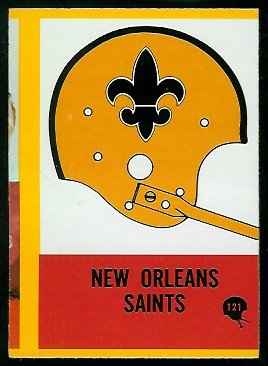
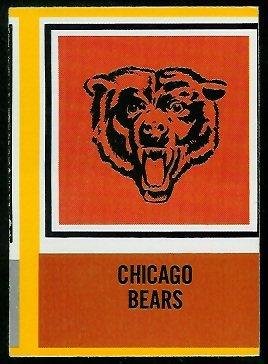
September 3rd, 2012 |
Published in
New in the Gallery
Today I added a few more pieces to my partially completed virtual uncut sheet of 1957 Topps football cards. Below are two miscut cards that provided clues: a Dick Bielski card with a bit of Elroy Hirsch showing on the left side, and the back of a Paul Hornung card that shows a sliver of Sid Youngelman’s card along the bottom. You can click on either card to see how the sheet is progressing.
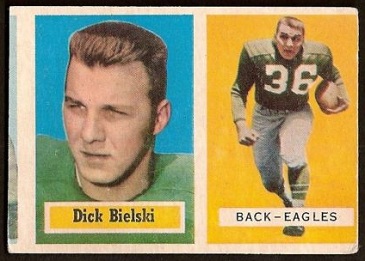
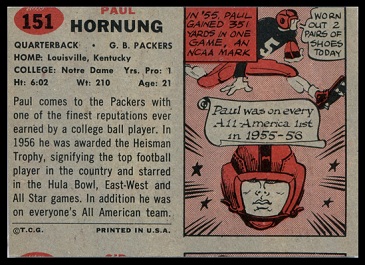
For a full list of the virtual uncut sheets I have assembled, see my article U is for Uncut Sheets. As always, if you happen to have pictures of full sheets, partial sheets, or miscut cards that would help the effort, please send me an email.
August 8th, 2012 |
Published in
New in the Gallery
Yesterday I showed you some miscut 1967 Topps cards that I picked up at the National; today I have a handful of 1961 Topps cards. I hope to collect enough of these to determine what uncut sheets of 1961 Topps cards looked like. I have not seen an uncut sheet, partial sheet, panel, or strip of 1961 Topps cards, so I am starting from scratch with this set. To see what I have so far, check out my 1961 Topps virtual uncut sheet page. As always, if you have miscut cards that would help the project, I would love to see them.
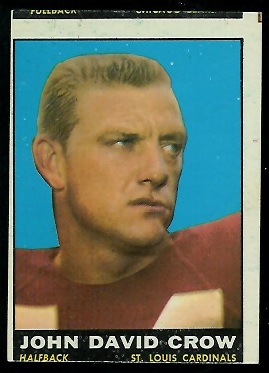
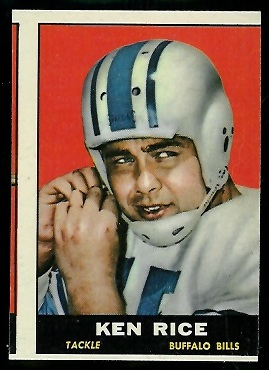
April 9th, 2012 |
Published in
New in the Gallery
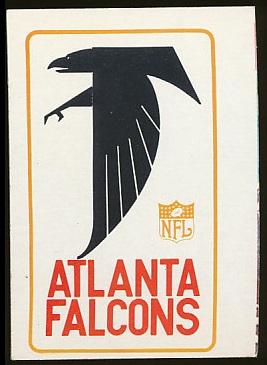 Last year, after looking at a number of badly miscut cards, I concluded that uncut sheets of 1965, 1966, and 1967 Philadelphia football cards all had the same numbering scheme. So, from a picture of a half-sheet of 1966 Philadelphia cards, I was able to construct virtual half-sheets of 1965 and 1967 Philadelphia cards, as well. Unfortunately, I have not seen an example of the other half-sheet from any of the three sets, but I have been slowly piecing one together by looking at more miscut cards. Last weekend I added a few more pieces, and the second half-sheet took more shape. One of the new pieces is shown here: it’s a miscut 1966 Atlanta Falcons card that has a tiny piece of a Don Perkins card in the lower left corner.
Last year, after looking at a number of badly miscut cards, I concluded that uncut sheets of 1965, 1966, and 1967 Philadelphia football cards all had the same numbering scheme. So, from a picture of a half-sheet of 1966 Philadelphia cards, I was able to construct virtual half-sheets of 1965 and 1967 Philadelphia cards, as well. Unfortunately, I have not seen an example of the other half-sheet from any of the three sets, but I have been slowly piecing one together by looking at more miscut cards. Last weekend I added a few more pieces, and the second half-sheet took more shape. One of the new pieces is shown here: it’s a miscut 1966 Atlanta Falcons card that has a tiny piece of a Don Perkins card in the lower left corner.
To see my progress on the second half-sheet, go to the Uncut Sheets in Progress page and scroll down to the bottom. For a full list of my virtual uncut sheets, see a previous blog article, U is for Uncut Sheets.
February 18th, 2012 |
Published in
New in the Gallery
Yesterday I added a virtual uncut sheet of 1962 Fleer football cards to the Vintage Football Card Gallery. By studying miscut cards from the set, my friend Paul puzzled out the numbering pattern of the cards on the sheet. Most of the cards that are scarce in high grades are grouped together on the sheet, and I added a diagram to show that.
The Gallery now includes virtual uncut sheets for 27 football card sets. For the full list, see one of my previous blog articles, U is for Uncut Sheets.
(Click on the image to see the full virtual sheet.)
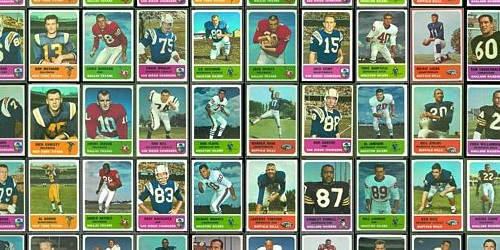
December 22nd, 2011 |
Published in
Football Card Trivia
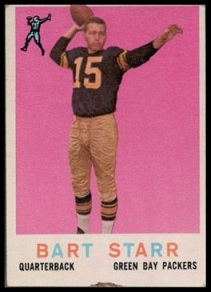 If you collect 1959 Topps football cards, you probably have seen cards with a dark mark on the bottom. You probably also have figured out that the dark mark is from the card below on the uncut sheet. Topps got a little artsy in 1959 and let the images of the players extend into the top border. Consequently, the cards don’t have to be too far off-center to have gotten a bit of the card below.
If you collect 1959 Topps football cards, you probably have seen cards with a dark mark on the bottom. You probably also have figured out that the dark mark is from the card below on the uncut sheet. Topps got a little artsy in 1959 and let the images of the players extend into the top border. Consequently, the cards don’t have to be too far off-center to have gotten a bit of the card below.
Shown here is an example, a Bart Starr card that is shifted far enough upward that it shows a bit of another player’s scalp. The other player in this case happens to be Ernie Stautner. In turn, the football in Starr’s hand extended into the top border, and most of the ball ended up on the bottom of someone else’s card.
So what, you ask? Well, I am piecing together a virtual uncut sheet of first series 1959 Topps cards, and clues from off-center cards are helping me piece the sheet together. You can see the modest beginnings of a first series sheet on my Virtual Uncut Sheets in Progress page. You can help: if you find another 1959 Topps first series card that shows a bit of a neighboring card, send me a picture of it.
What about the second series 1959 Topps sheet? Well, that one was easy, because I found a picture of a real one. You can see the virtual version in the Vintage Football Card Gallery.
October 22nd, 2011 |
Published in
New in the Gallery
Yesterday I added a virtual uncut sheet of 1964 Philadelphia football cards to the Vintage Football Card Gallery. I modeled the virtual sheet after a real one that is for sale in an upcoming auction. Thanks to Steve of the thecowboysguide.com for pointing out the auction.
Whereas 1965, 1966, and 1967 Philadelphia sheets appear to have had the same card numbering scheme, the 1964 Philadelphia sheet is numbered differently. On the 1964 sheet, groups of five to ten teammates appear on consecutive cards in the same row. I suspect that this caused a lot of teammates to appear together in packs, and that’s why Philadelphia changed their numbering scheme in 1965 to one that appeared more random.
(Click on the image to see the full virtual sheet.)
